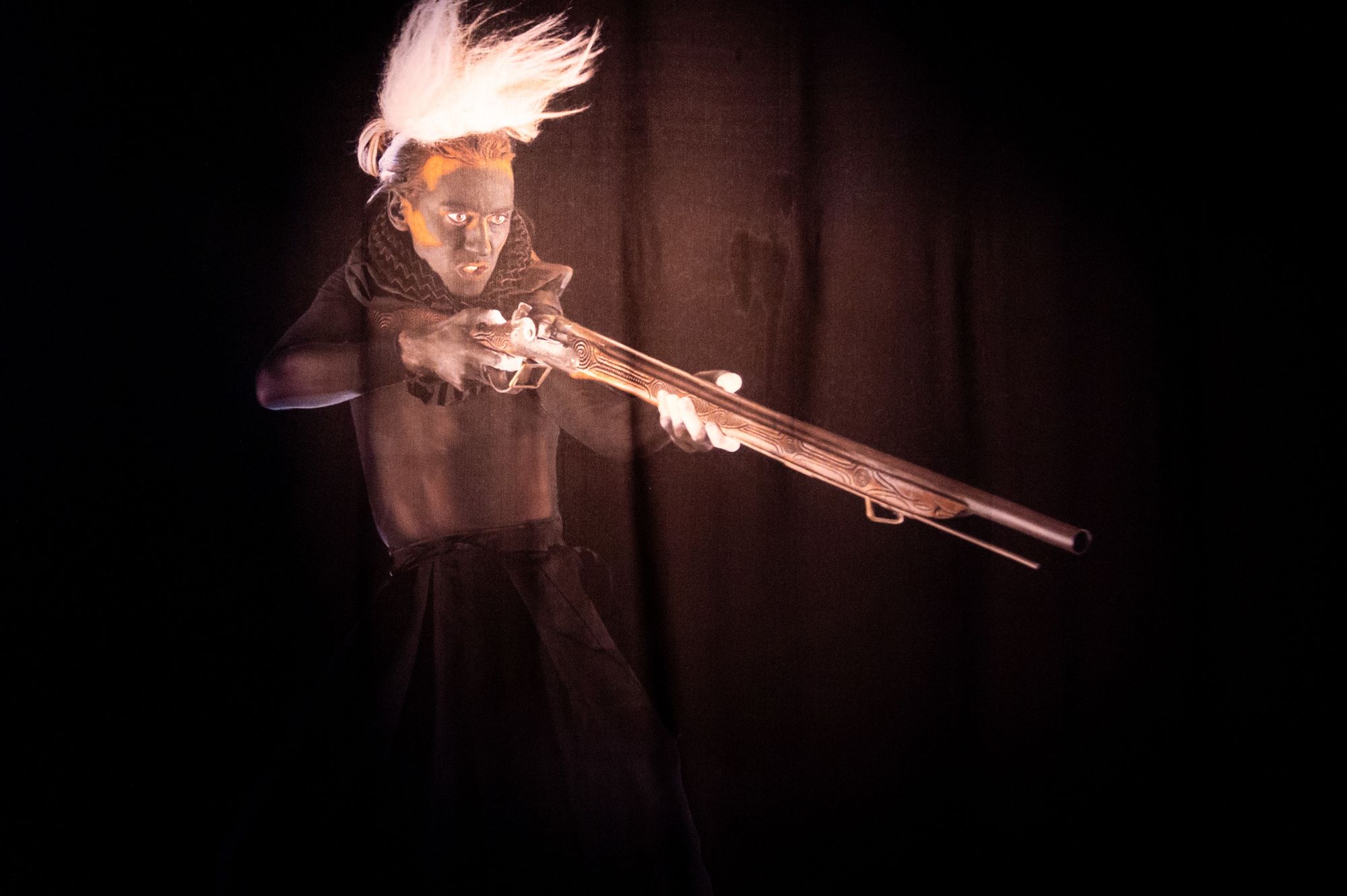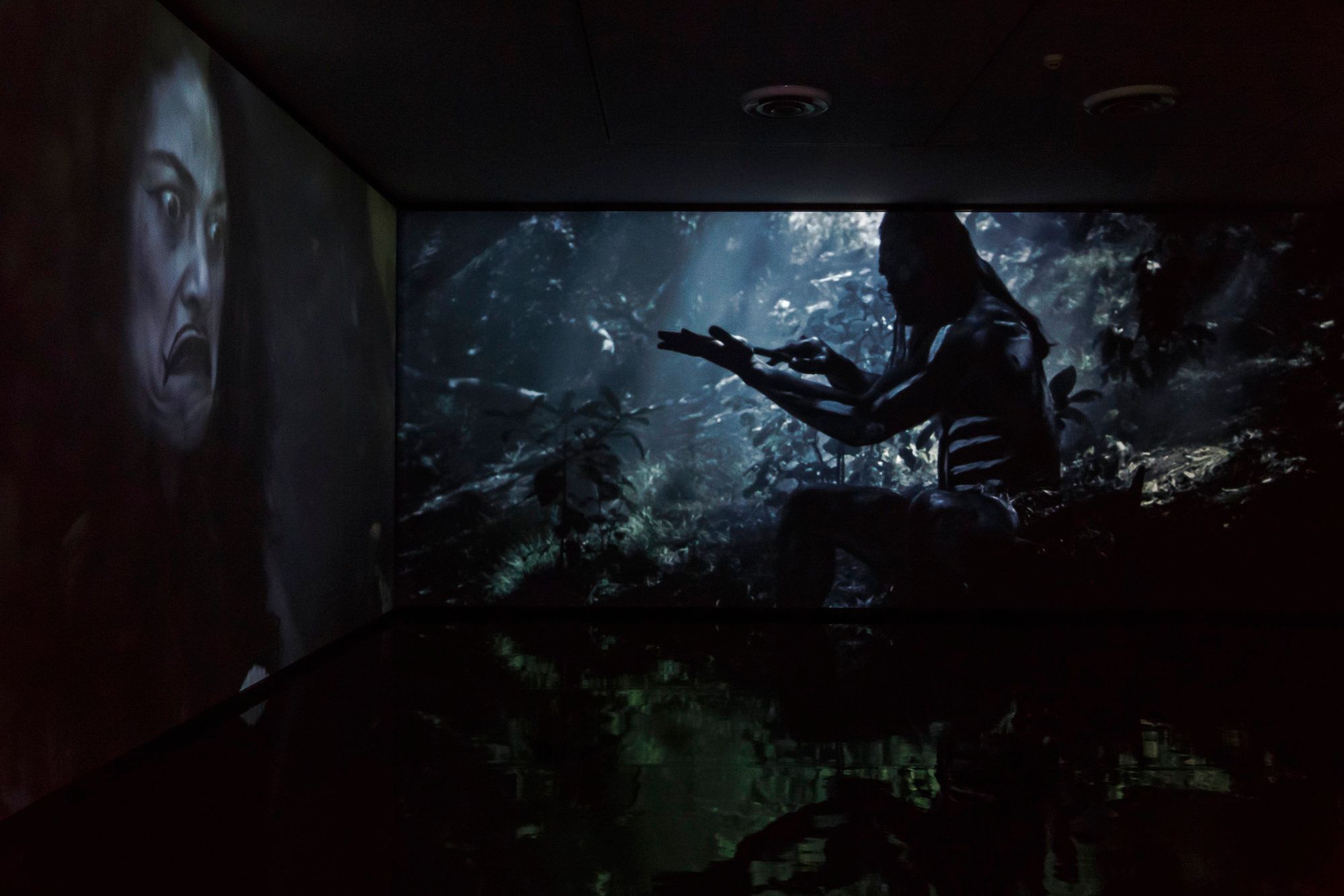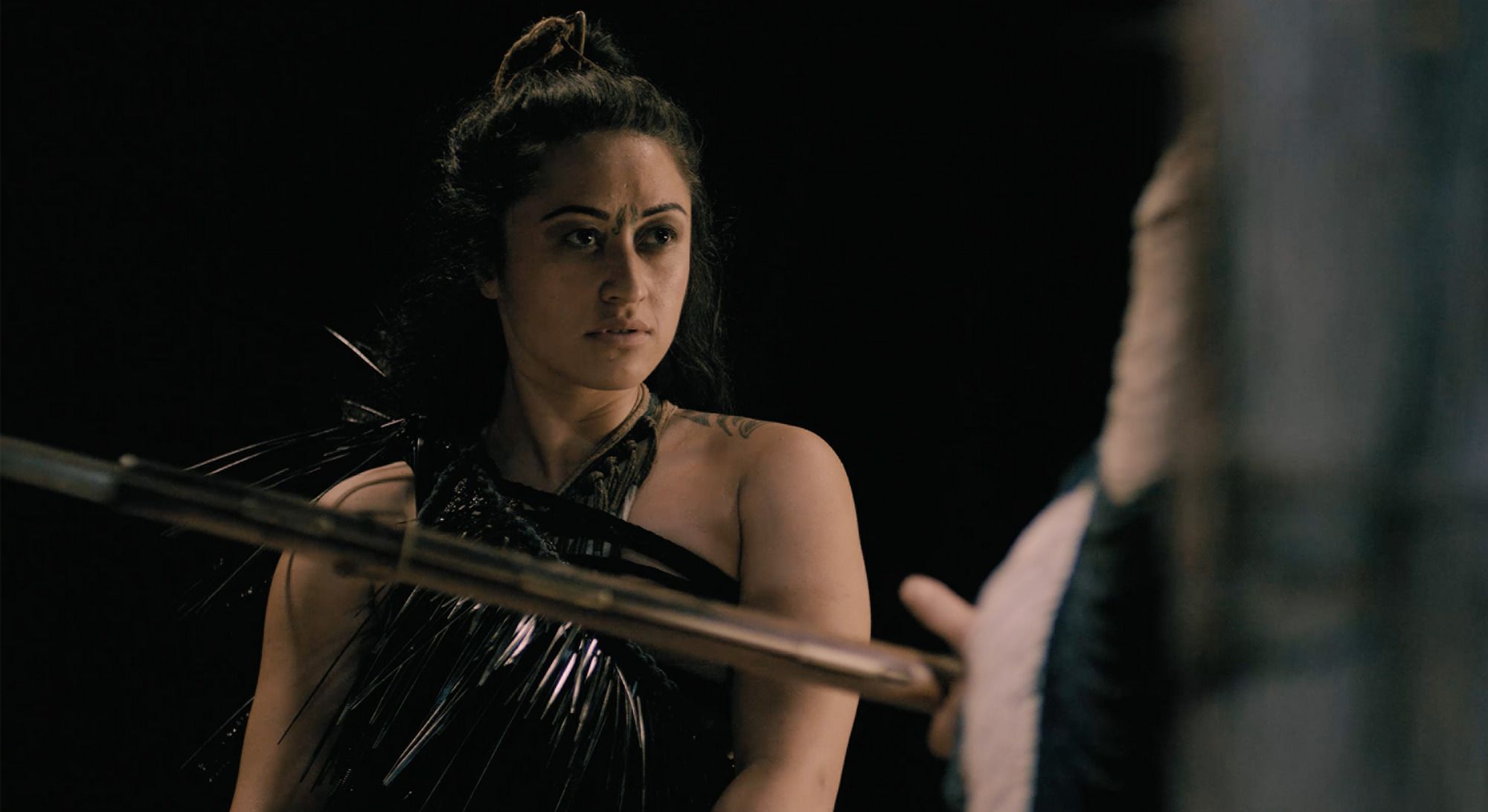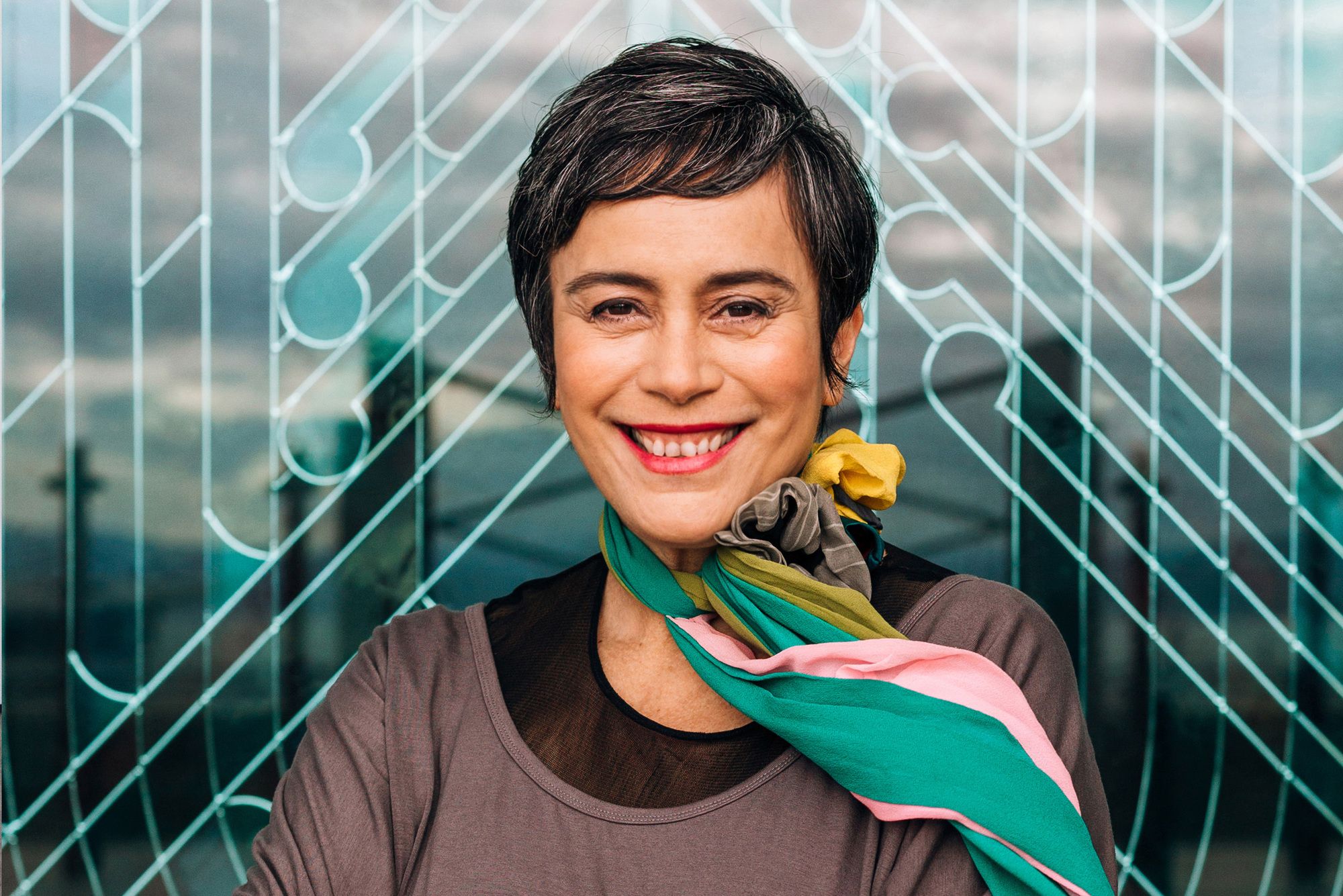Seeing and Feeling the Essence of Lisa Reihana
Jahra Wasasala responds to the exhibition Lisa Reihana: Nomads of the Sea, through woven experiences of movement, non-linear time and a collection of collisions.
For context, I am writing this from my place of seeing, which I hope translates to a shared collective sight as well. Na yacaqu o Jahra Wasasala. I am Fijian and Pākehā. Au gone ni Macuata. Na noqu koro o Naduri. Na noqu koro ni vasu o Tāmaki Makaurau.
I write this collection of moments on the unceded whenua and region of Te Whanganui-a-Tara, specifically in Te Awakairangi ki Uta, where I currently live. These moments I have written about happened in no particular order, in no linear time. A collection of collisions experienced in body-time.
BODY-FIRST, YALO-FIRST, BECAUSE ENGLISH GIVES ME WHIPLASH
Humans tend to be obsessed with understanding everything. Obsessed with obtaining information on something before we risk experiencing it. The obsession runs so deep that many people create industries dedicated to static knowledge. For some, to understand something is to be able to name it and keep it in a single place, meaning you surely must have conquered that piece of the unknown. From where I exist, one of the truths of creative offerings that are made public is that they are the residue of a long-term relationship with the incomprehensible, with the ’knowing’. (‘Knowing’ is different from ‘understanding’, in the same way as the ability of ‘feeling’ is different from ‘emotions’, but that’s another talanoa).
I always feel pulled apart when I have to weave experiences together in English. Describing something intangible, something ephemeral in a language full of smoke and mirrors feels like I am wrestling with a ghost. And on top of that, having English as my most prominent oral language (at this moment) makes the fight seem rigged, or infected. Years ago, as a poet, I adored the ability to make this jigsaw language bend and break between my teeth. Poetry felt like a taste of retribution within a language of laws, tricks and absolutes. But it is a fight nonetheless. And every fight is labour. This is probably a reason I felt pulled towards using my body as my main communicator.
For me, my tubuna, my before-now-memory, speak the clearest to me through my body.
Because of all of this, I don’t believe in describing anyone’s creative offerings didactically. For me, it strips the work of its body and of its purpose. Instead I will focus on the feeling, because that translates as the most truth-orientated (for me anyway) for the intention of many artists’ works.
Our body remembers the old worlds. Our body can hold multiverses. Our body constantly goes beyond the worlds we know. Our body has seen this all before. So I will use these following words and letters as best as I can to mould around our collective body, just as Lisa Reihana’s worlds have moulded around mine.
Image: Lisa Reihana: Te Wai Ngunguru – Nomads of The Sea, 2019, Photo by: Elias Rodriguez, Studio Mark Tantrum.
NO PAIN, RATHER A WAVE OF QUIET
When I encounter a body of work from an Indigenous artist, my experience is always centred around seeing it through my form. A body-first kind-of-sight. The first time I witnessed Lisa Reihana’s visions was in her landmark work, in Pursuit of Venus [infected].
Speaking body-first: A work with daunting presence, through size and intention, swallows and floods. This is a deeply comforting sensation, reminiscent of being in front of the Moana. Walking into that exhibition space for the first time, I felt my jaw lock. The feeling was gentle, but it locked. The tension crawled throughout my face. A slow, deep, dragging feeling then pulled me towards a seated position on the floor, as if my stomach dropped and brought the ceiling down with it in slow motion. I wasn’t able to move for a couple of hours before it released itself. There was no pain or discomfort, rather a wave of quiet that settled over me.
A work with daunting presence, through size and intention, swallows and floods. This is a deeply comforting sensation, reminiscent of being in front of the Moana.
In a reality loaded with overstimulation, a body can direct itself to empty its senses when it has to make way for visions to be seen. And what I saw was a multiverse. A multiverse of what was, what wasn’t, what we remembered, what we forgot, what could and shouldn’t have been, all at once. Several versions of time folding onto itself. A tongue being twisted in the mouth mid-sentence. Trauma and dreams being told and held together. A multitude of memories that have been tainted. Visions in no particular order, with names that keep changing. That’s what I experience with Lisa Reihana’s work: visions.
Not singular, but plural. Multiple ways of seeing, all at once.
Image: Lisa Reihana. Ihi (video still), 2020. Aotearoa New Zealand Festival of the Arts. Artist in Focus 2022. Photo by Anna Briggs
TAI WHETUKI – HOUSE OF DEATH
This body is a home for voices that have too much blood within them
One of the truths is
you must intimately know the terror within
to disembowel the terror placed upon
/
This is not a tongue
inside of our mouth
an Atua
throws itself against the walls
the sound leaks through teeth
as a stutter
as a prayer
finding its-body
/
I whakanoa / I wash my hands and exit.
Image: Lisa Reihana Tai Whetuki - House of Death Redux (video still), 2015. Aotearoa New Zealand Festival of the Arts. Artist in Focus 2022. Photo by Anna Briggs
GOD-BODIES ARE FRIENDS’ BODIES
One of the most personally impactful effects of Lisa Reihana’s work Ihi held within the exhibition Nomads of the Sea is that I recognise the featured performers as my kin. I know these people personally. I recognise Nancy Wijohn, Taane Mete and Rosanna Raymond (featured in Tai Whetuki – House of Death Redux) as friends, as teachers and mentors I have had, as peers within Indigenous dance-centred spaces, as people who have made space for me. I recognise them as artists who have carved their names into the belly of Aotearoa Indigenous performance and activation whakapapa. In turn, they have also collectively known me for nearly ten years, since I was a teenager. We have watched each other grow and change and become. There is intergenerational knowing shared between us, as it is shared between Lisa Reihana and the performers, as it is shared between the work Ihi and the audience.
Seeing friends have their ‘Atua-bodies uplifted and magnified is everything. Finding these claimed realities within the chaos of all of the projections and depictions we are subject to throughout our navigation of this world is breath-giving. Lisa Reihana’s work Ihi embodies something potent that can transform a young person’s perception of themselves and their own people. Ihi reminds us that we are bodying our ‘Atua, in real time. Ihi reminds me, as a descendant of Te Moana-Nui-a-Kiwa but not from this whenua, to listen and to see. And I mean SEE: see with body, see with voice, see with accountability, and see with deepening knowing. Ihi reminds us that we have the ability to share the same full-throated voice of our ‘Atua. Ihi reminds me that my friends’ tūpuna walk and breathe and move within them, and that my tubuna converse with theirs when we are in relationship with each other. As they do when I am in relationship with them through Lisa Reihana’s work.
Image: Lisa Reihana, Te Wai Ngunguru – Nomads of the Sea (video still), 2019. Aotearoa New Zealand Festival of the Arts. Artist in Focus 2022. Photo by Anna Briggs
THE TRUTH ABOUT STORIES IS THAT THEY’RE ALL WE ARE
I walk through Nomads of the Sea, holding a body of multiple works from Lisa Reihana. I remember the way in which acclaimed Indigenous writer Thomas King wrote his book The Truth About Stories: A Native Narrative, in the form of a story that reshapes itself every time it is spoken, and is reshaped in every chapter of the book:
“There is a story I know. It is about the earth and how it floats in space on the back of a turtle. I’ve heard this story many times, and each time someone tells this story, it changes. Sometimes the change is simply in the voice of the story-teller. Sometimes the change is in the details. Sometimes in the order of events. Other times it’s the dialogue or the response of the audience.
But in all the tellings of all the tellers, the world never leaves the turtle’s back. And the turtle never swims away.”
Witnessing Lisa Reihana’s works, I remember. Within kinships, within gafa, within our genealogies, every work, every offering made is a storyteller. Every offering is a change in the voice. Every offering is a change in the details or the order of events. Every telling is being told from the same ancestral body of memory and visions. The memory and visions never leave our ancestral body. And our ancestral body never moves away.
Image: Lisa Reihana by Anna Briggs
Following on from Reihana’s acclaimed survey, Cinemania, at Campbelltown Art Centre as part of the 2018 Sydney Festival program, Lisa Reihana: Nomads of the Seapresented works made over the last 15 years. The exhibition focused on Reihana’s distinctive exploration of large-scale, immersive installations and offers insight into her weaving together numerous threads, from museology, archives and historical accounts, to pūrakau Māori, whakapapa and Māori belief systems.
Pātaka’s exhibition included the Aotearoa premiere of Te Wai Ngunguru - Nomads of the Sea (2019), previously exhibited in NIRIN, the 22nd Biennale of Sydney (2020).Image: Lisa Reihana, Te Wai Ngunguru - Nomads of the Sea, still, 2019. 3-channel UHD video: 17-min
Co-commissioned by Sharjah Art Foundation. Funding Support: Creative New Zealand, Nga Aho Whakaari, Te Taura Whiri Maori Language Commission and Jan Warburton Charitable Trust.
Co-produced by Artprojects and Reihanamations Ltd.
*
This piece is presented as part of a partnership with Pātaka Art + Museum. They cover the costs of paying our writers while we retain all editorial control.
Feature image: Lisa Reihana, Te Wai Ngunguru – Nomads of the Sea (video still), 2019. Aotearoa New Zealand Festival of the Arts. Artist in Focus 2022. Photo by Anna Briggs







